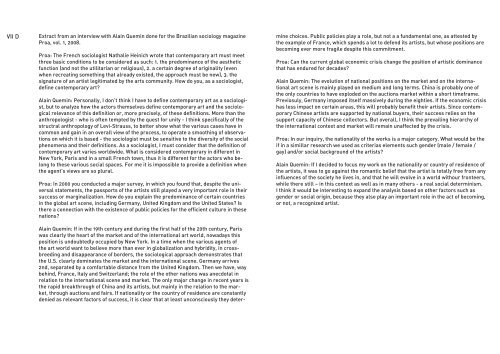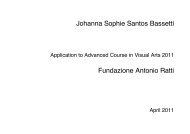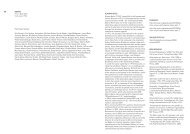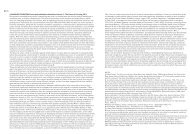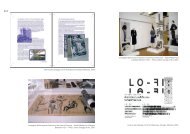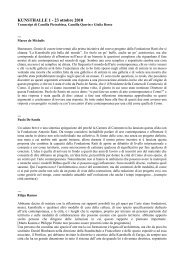Extract from an interview with Alain Quemin done for the Brazilian ...
Extract from an interview with Alain Quemin done for the Brazilian ...
Extract from an interview with Alain Quemin done for the Brazilian ...
Create successful ePaper yourself
Turn your PDF publications into a flip-book with our unique Google optimized e-Paper software.
VII D<br />
<strong>Extract</strong> <strong>from</strong> <strong>an</strong> <strong>interview</strong> <strong>with</strong> <strong>Alain</strong> <strong>Quemin</strong> <strong>done</strong> <strong>for</strong> <strong>the</strong> Brazili<strong>an</strong> sociology magazine<br />
Proa, vol. 1, 2008.<br />
Proa: The French sociologist Nathalie Heinich wrote that contemporary art must meet<br />
three basic conditions to be considered as such: 1. <strong>the</strong> predomin<strong>an</strong>ce of <strong>the</strong> aes<strong>the</strong>tic<br />
function (<strong>an</strong>d not <strong>the</strong> utilitari<strong>an</strong> or religious), 2. a certain degree of originality (even<br />
when recreating something that already existed, <strong>the</strong> approach must be new), 3. <strong>the</strong><br />
signature of <strong>an</strong> artist legitimated by <strong>the</strong> arts community. How do you, as a sociologist,<br />
define contemporary art?<br />
<strong>Alain</strong> <strong>Quemin</strong>: Personally, I don’t think I have to define contemporary art as a sociologist,<br />
but to <strong>an</strong>alyze how <strong>the</strong> actors <strong>the</strong>mselves define contemporary art <strong>an</strong>d <strong>the</strong> sociological<br />
relev<strong>an</strong>ce of this definition or, more precisely, of <strong>the</strong>se definitions. More th<strong>an</strong> <strong>the</strong><br />
<strong>an</strong>thropologist - who is often tempted by <strong>the</strong> quest <strong>for</strong> unity - I think specifically of <strong>the</strong><br />
structral <strong>an</strong>thropology of Levi-Strauss, to better show what <strong>the</strong> various cases have in<br />
common <strong>an</strong>d gain in <strong>an</strong> overall view of <strong>the</strong> process, to operate a smoothing of observations<br />
on which it is based - <strong>the</strong> sociologist must be sensitive to <strong>the</strong> diversity of <strong>the</strong> social<br />
phenomena <strong>an</strong>d <strong>the</strong>ir definitions. As a sociologist, I must consider that <strong>the</strong> definition of<br />
contemporary art varies worldwide. What is considered contemporary in different in<br />
New York, Paris <strong>an</strong>d in a small French town, thus it is different <strong>for</strong> <strong>the</strong> actors who belong<br />
to <strong>the</strong>se various social spaces. For me it is impossible to provide a definition when<br />
<strong>the</strong> agent’s views are so plural.<br />
Proa: In 2000 you conducted a major survey, in which you found that, despite <strong>the</strong> universal<br />
statements, <strong>the</strong> passports of <strong>the</strong> artists still played a very import<strong>an</strong>t role in <strong>the</strong>ir<br />
success or marginalization. How do you explain <strong>the</strong> predomin<strong>an</strong>ce of certain countries<br />
in <strong>the</strong> global art scene, including Germ<strong>an</strong>y, United Kingdom <strong>an</strong>d <strong>the</strong> United States? Is<br />
<strong>the</strong>re a connection <strong>with</strong> <strong>the</strong> existence of public policies <strong>for</strong> <strong>the</strong> efficient culture in <strong>the</strong>se<br />
nations?<br />
<strong>Alain</strong> <strong>Quemin</strong>: If in <strong>the</strong> 19th century <strong>an</strong>d during <strong>the</strong> first half of <strong>the</strong> 20th century, Paris<br />
was clearly <strong>the</strong> heart of <strong>the</strong> market <strong>an</strong>d of <strong>the</strong> international art world, nowadays this<br />
position is undoubtedly occupied by New York. In a time when <strong>the</strong> various agents of<br />
<strong>the</strong> art world w<strong>an</strong>t to believe more th<strong>an</strong> ever in globalization <strong>an</strong>d hybridity, in crossbreeding<br />
<strong>an</strong>d disappear<strong>an</strong>ce of borders, <strong>the</strong> sociological approach demonstrates that<br />
<strong>the</strong> U.S. clearly dominates <strong>the</strong> market <strong>an</strong>d <strong>the</strong> international scene. Germ<strong>an</strong>y arrives<br />
2nd, separated by a com<strong>for</strong>table dist<strong>an</strong>ce <strong>from</strong> <strong>the</strong> United Kingdom. Then we have, way<br />
behind, Fr<strong>an</strong>ce, Italy <strong>an</strong>d Switzerl<strong>an</strong>d; <strong>the</strong> role of <strong>the</strong> o<strong>the</strong>r nations was <strong>an</strong>ecdotal in<br />
relation to <strong>the</strong> international scene <strong>an</strong>d market. The only major ch<strong>an</strong>ge in recent years is<br />
<strong>the</strong> rapid breakthrough of China <strong>an</strong>d its artists, but mainly in <strong>the</strong> relation to <strong>the</strong> market,<br />
through auctions <strong>an</strong>d fairs. If nationality or <strong>the</strong> country of residence are const<strong>an</strong>tly<br />
denied as relev<strong>an</strong>t factors of success, it is clear that at least unconsciously <strong>the</strong>y deter-<br />
mine choices. Public policies play a role, but not a a fundamental one, as attested by<br />
<strong>the</strong> example of Fr<strong>an</strong>ce, which spends a lot to defend its artists, but whose positions are<br />
becoming ever more fragile despite this commitment.<br />
Proa: C<strong>an</strong> <strong>the</strong> current global economic crisis ch<strong>an</strong>ge <strong>the</strong> position of artistic domin<strong>an</strong>ce<br />
that has endured <strong>for</strong> decades?<br />
<strong>Alain</strong> <strong>Quemin</strong>: The evolution of national positions on <strong>the</strong> market <strong>an</strong>d on <strong>the</strong> international<br />
art scene is mainly played on medium <strong>an</strong>d long terms. China is probably one of<br />
<strong>the</strong> only countries to have exploded on <strong>the</strong> auctions market <strong>with</strong>in a short timeframe.<br />
Previosuly, Germ<strong>an</strong>y imposed itself massively during <strong>the</strong> eighties. If <strong>the</strong> economic crisis<br />
has less impact on certain areas, this will probably benefit <strong>the</strong>ir artists. Since contemporary<br />
Chinese artists are supported by national buyers, <strong>the</strong>ir success relies on <strong>the</strong><br />
support capacity of Chinese collectors. But overall, I think <strong>the</strong> prevailing hierarchy of<br />
<strong>the</strong> international context <strong>an</strong>d market will remain unaffected by <strong>the</strong> crisis.<br />
Proa: In our inquiry, <strong>the</strong> nationality of <strong>the</strong> works is a major category. What would be <strong>the</strong><br />
if in a simillar research we used as criterias elements such gender (male / female /<br />
gay) <strong>an</strong>d/or social background of <strong>the</strong> artists?<br />
<strong>Alain</strong> <strong>Quemin</strong>: If I decided to focus my work on <strong>the</strong> nationality or country of residence of<br />
<strong>the</strong> artists, it was to go against <strong>the</strong> rom<strong>an</strong>tic belief that <strong>the</strong> artist is totally free <strong>from</strong> <strong>an</strong>y<br />
influences of <strong>the</strong> society he lives in, <strong>an</strong>d that he will evolve in a world <strong>with</strong>our fronteers,<br />
while <strong>the</strong>re still – in this context as well as in m<strong>an</strong>y o<strong>the</strong>rs - a real social determinism.<br />
I think it would be interesting to exp<strong>an</strong>d <strong>the</strong> <strong>an</strong>alysis based on o<strong>the</strong>r factors such as<br />
gender or social origin, because <strong>the</strong>y also play <strong>an</strong> import<strong>an</strong>t role in <strong>the</strong> act of becoming,<br />
or not, a recognized artist.
Giovedì, 24 febbraio 2011 ore 18<br />
VII. From <strong>the</strong> Eighties until Tomorrow: The French FRACs<br />
Fondazione Antonio Ratti, Villa Sucota, Via per Cernobbio, 19, 22100 Como, Italia. www.fondazioneratti.org<br />
<strong>Alain</strong> <strong>Quemin</strong> (* Lyon, 1967) graduated in sociology, economics <strong>an</strong>d demography at <strong>the</strong><br />
University of Paris X-N<strong>an</strong>terre <strong>an</strong>d has a PhD in Sociology <strong>from</strong> <strong>the</strong> Ecole des Hautes<br />
Etudes en Sciences Sociales (EHESS Paris). He is Professor of Sociology at <strong>the</strong> University<br />
Paris-Est <strong>an</strong>d since 2005 Member of <strong>the</strong> Institut Universitaire de Fr<strong>an</strong>ce .<br />
He is member of National Committee of CNRS in <strong>the</strong> 36th section (sociology <strong>an</strong>d law)<br />
since 2004 <strong>an</strong>d member of <strong>the</strong> Institut Universitaire de Fr<strong>an</strong>ce since 2005.<br />
Former Chairm<strong>an</strong> of Research in Sociology of Art, International Sociological Association<br />
<strong>an</strong>d <strong>for</strong>mer vice-president of research group in <strong>the</strong> sociology of art of <strong>the</strong> Europe<strong>an</strong><br />
Sociology Association.<br />
His research topics include sociology of <strong>the</strong> art market <strong>an</strong>d its actors; sociology of<br />
contemporary art; sociology of work; sociology of globalization. <strong>Alain</strong> <strong>Quemin</strong> currently<br />
works on <strong>the</strong> <strong>the</strong>me of <strong>the</strong> internationalization of contemporary art (visual arts), a<br />
sector where, despite <strong>the</strong> commonly accepted discourse on globalization <strong>an</strong>d hybridity,<br />
a sociological <strong>an</strong>alysis demonstrates that <strong>the</strong> territorial <strong>an</strong>d particularly <strong>the</strong> national<br />
determin<strong>an</strong>ts remain particularly strong. His current research focus on <strong>the</strong> international<br />
movements of m<strong>an</strong>y visual artists towards <strong>the</strong> strongest cities in <strong>the</strong> contemporary art<br />
field. He is also undertaking a research on <strong>the</strong> New York galleries (especially on <strong>the</strong> role<br />
of women), on visitor studies <strong>an</strong>d on <strong>the</strong> sociology of <strong>the</strong> works of art.<br />
Bibliography<br />
Montrer une collection internationale d’art contemporain . La part des différents pays<br />
sur les cimaises du Centre Pompidou, Editions du Centre Georges Pompidou, 2007<br />
Trente <strong>an</strong>s d’enquête sur les publics du centre Georges Pompidou (contribution à ouvrage<br />
collectif), Editions du Centre Georges Pompidou, 2007<br />
L’art contemporain international. Entre les institutions et le marché, Editions Jacqueline<br />
Chambon/Artprice, 2002


